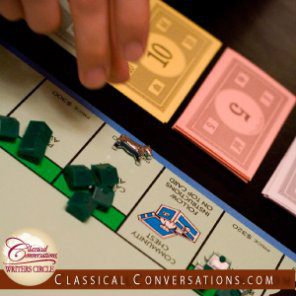My favorite day of the week is always our Classical Conversations community day, but I also really enjoy the more relaxed days of the Christmas break. We study the things we like at our own pace for a few weeks and I have time to work some games into regular school hours. We also take advantage of the dark, cold winter evenings to play games together. My family loves Monopoly, Bananagrams, and Boggle. If another family or two can join us, we play Charades or Trivial Pursuit for Kids. I have the happiest memory of my own father acting out “Peter Rabbit” in a game of Charades. There is nothing funnier than a dad acting out some classic literature for his family. These are some of our favorite Christmas blessings: time to laugh and play together as a family.
I have also learned a few fun games that help drill math facts. Change the rules to suit the ages you have; the main thing is to have some fun while you sneak in a little math.
Take the Cards
Draw a card from the deck and put it down where everyone can see it. This will be the multiplying factor for the round, so it will stay there the whole round. I take the top card from the deck and place it face up where everyone can see it. The first person who can multiply the two numbers gets to keep the card. We go through the entire deck and see who has the most cards at the end. (I assign Jacks the value of eleven, and Kings and Queens the value of twelve.)
There are hundreds of variations possible with this format. Have your student add nine to each card, or tell you the “Sum Ten” of each card, which means they tell you what they need to add to the card to make ten. Then, move on to the “Sum Nine” of each card. Older students can do two or more operations such as, “multiply by seven and add two.”
If you have more than two players, make teams and have two players from each team face off. The one who wins the card plays again, the one who loses the card goes to the back of the line of his team. (The nice thing about this game is that you will get four repetitions of each problem as you go through the deck of cards, so if they are paying attention, the kids will learn the answers by the time you get to the bottom of the deck.)
Board Slam
On a whiteboard, or plain paper in a page protector, write the numbers one through thirty-six. Each person gets a turn to roll three dice and do whatever computation they can think of to come up with an answer that is on the board. They put an “x” on the answer. They can multiply, divide, add, subtract, or square the numbers they roll, but they have to use all three numbers in the equation. When the next person takes a turn, they put a different color “x” on the number. The first person to get four “x’s” in a row wins that round. This game can really help kids build some speed at mental math because they will work several problems in their heads trying to get specific answers.
Coin Grab and Add
I have all the kids close their eyes and I sprinkle coins all over the floor of the living room. When I say, “Go!” they open their eyes and collect as many coins as they can. Each student has to count up the money they have and the one with the most money wins the round. We also like to play this game in the swimming pool in the summer. You would think the older kids would outgrow this one, but they occasionally enjoy playing just to help their younger siblings learn to count money.
I hope your family enjoys these Christmas blessings. Love one another and laugh often.




